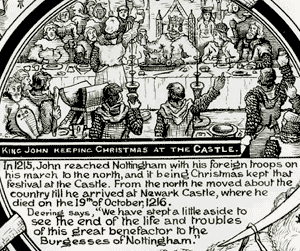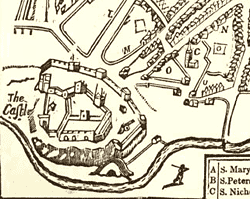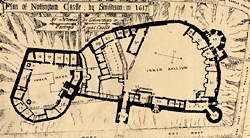The Park - a Medieval Inheritance
Visitors to Nottingham Castle are often surprised by the building which now bears that name. It is far from the medieval castle they associate with Robin Hood and the Sheriff of Nottingham.
The first Nottingham Castle, begun in 1087 shortly after the Norman Conquest, was a wooden building consisting of a motte and two baileys. This was soon replaced by a heavily defended stone structure with two further baileys. As a key royal castle in the midlands, Nottingham was visited frequently by Henry II (1133-1189) and became a favoured residence of King John (c.1167-1216).

King John keeping Christmas at the castle from F Clements, From Whence Nottingham Sprang, Part II (Nottingham, 1891)
The Park adjoining the Castle was forested and stocked with deer. It contained fishponds and a rabbit warren and Henry II - 'addicted to hunting beyond measure' - added a falconry. The area thus provided both food and sport for castle residents.
By the seventeenth century the Castle had declined in importance, although John Speed's map (1610) shows its strategic prominence for the city. The civil war years saw both the raising of the royal standard in 1642 and the defence of the Castle by Colonel Hutchinson. After its capture by Cromwell's forces, the Park was deforested to provide supplies, and in 1651 the Castle was demolished by Parliamentary order. In 1663, when William Cavendish, 1st Duke of Newcastle upon Tyne, purchased the structure, he bought a ruin.
The re-use of the site for the duke's new mansion left little trace of the medieval stonework and historians like Hine were required to look back on earlier evidence, like the plan drawn by John Smithson.

Detail from John Speed's Ancient Map of Nottingham (1610)

Plan of Nottingham Castle by John Smithson in 1610 from T C Hine, 'Nottingham: Its Castle' (London, 1876)
More: Mapping Residential Expansion
Nottingham Park: From Ducal Estate to Urban Residence home